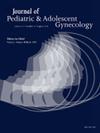44. 自身免疫性卵巢炎的卵泡发现:来自NIH卵巢组织冷冻保存方案的2例
IF 1.7
4区 医学
Q3 OBSTETRICS & GYNECOLOGY
引用次数: 0
摘要
自身免疫性卵巢炎和随后的卵巢储备功能减退(DOR)或卵巢早衰(POI)是一种罕见的低生育能力原因,约占自发性POI的4%。它通常与甲状腺和/或肾上腺自身免疫共存,也可能是I型和II型多腺体自身免疫综合征(APS)的一部分。本研究的目的是描述儿童/青少年自身免疫性DOR/POI的几个病例,以及他们的卵巢组织发现,以帮助告知这种罕见疾病的管理。病例患者A是一名16岁的女性,有因子V Leiden杂合病史,在突发性脱发检查中被诊断为POI,实验室检测到FSH升高(129 mIU/mL)和雌二醇未检出。她还发现有抗甲状腺过氧化物酶抗体、抗甲状腺球蛋白抗体和抗肾上腺抗体,引起对多腺自身免疫功能衰竭的关注。12岁开始月经初潮,她有规律的月经,在她被诊断出来的时候,月经变得更轻,但持续不断。她接受了腹腔镜右卵巢切除术和卵巢组织冷冻保存。卵巢组织学未见卵巢卵泡。患者B为13岁,最初表现为体重减轻、心悸和继发性闭经。初潮发生在11岁,随后有规律的月经,直到13岁突然停止。实验室证实格雷夫氏病(TSH <;0.005 mIU/L, T4 15.8 mcg/dL,促甲状腺免疫球蛋白413 IU/L),促性腺功能亢进症与POI一致(FSH 59.3 mIU/mL, LH 15.5 IU/L)。雌二醇8 pg/mL, AMH 0.01 ng/m)。她接受了腹腔镜右卵巢切除术和卵巢组织冷冻保存。卵巢组织学未见卵巢卵泡。本研究表明,由于自身免疫性卵巢炎导致的POI患者均未出现卵泡。与其他原因的POI相比,自身免疫性POI患者卵巢组织冷冻保存的结果可能更差,因为卵泡缺失。也就是说,对这种情况的年表知之甚少,早期发现和识别自身免疫性卵巢炎可能会改善生育结果。值得注意的是,这两名患者都是青春期后。目前尚不清楚自身免疫性POI患者的生育能力保存结果是否因青春期状态而异。需要更多的研究来确定谁是卵巢组织冷冻保存的最佳候选人,特别是对于罕见的POI原因,如自身免疫性卵巢炎。本文章由计算机程序翻译,如有差异,请以英文原文为准。
44. Follicular findings in autoimmune oophoritis: 2 cases from the NIH ovarian tissue cryopreservation protocol
Background
Autoimmune oophoritis and subsequent diminished ovarian reserve (DOR) or premature ovarian insufficiency (POI) is a rare cause of subfertility, representing approximately 4% of spontaneous POI. It often coexists with thyroid and/or adrenal autoimmunity, or can be a part of Polyglandular Autoimmune Syndrome (APS), Type I and Type II. The purpose of this study is to describe several cases of autoimmune DOR/POI in children/adolescents, as well as their ovarian tissue findings to help inform management of this rare condition.
Case
Patient A is a 16-year-old female with a history of Factor V Leiden heterozygous, who was diagnosed with POI during workup of sudden alopecia with labs notable for elevated FSH (129 mIU/mL) and undetectable estradiol. She was also noted to have anti-thyroid peroxidase antibodies, anti-thyroglobulin antibodies, and anti-adrenal antibodies, raising concern for polyglandular autoimmune failure. Menarche occurred at age 12 and she had regular menses, which became lighter but ongoing the time of her diagnosis. She underwent laparoscopic right oophorectomy and ovarian tissue cryopreservation. Ovarian histology demonstrated no ovarian follicles. Patient B is a 13-year-old who initially presented with weight loss, palpitations, and secondary amenorrhea. Menarche occurred at age 11 with subsequent regular menses until an abrupt stop at 13 years old. Labs demonstrated hyperthyroidism due to Grave's disease (TSH < 0.005 mIU/L, T4 15.8 mcg/dL, thyroid-stimulating immunoglobulin 413 IU/L) and hypergonadotropic hypogonadism consistent with POI (FSH 59.3 mIU/mL, LH 15.5 IU/L. estradiol 8 pg/mL, AMH 0.01 ng/m). She underwent laparoscopic right oophorectomy and ovarian tissue cryopreservation. Ovarian histology demonstrated no ovarian follicles.
Comments
This study demonstrated no follicles in either of the subjects with POI due to autoimmune oophoritis. It is possible that the absence of follicles represents generally worse outcomes of ovarian tissue cryopreservation for patients with autoimmune POI compared to other causes of POI. That said, little is known about the chronology of this condition, and earlier detection and recognition of autoimmune oophoritis might allow for improved fertility outcomes. Notably both of these patients were post-pubertal. It is unknown if fertility preservation outcomes for patients with autoimmune POI differ by pubertal status. More studies are needed to determine who are optimal candidates for ovarian tissue cryopreservation, especially for rare causes of POI like autoimmune oophoritis.
求助全文
通过发布文献求助,成功后即可免费获取论文全文。
去求助
来源期刊
CiteScore
3.90
自引率
11.10%
发文量
251
审稿时长
57 days
期刊介绍:
Journal of Pediatric and Adolescent Gynecology includes all aspects of clinical and basic science research in pediatric and adolescent gynecology. The Journal draws on expertise from a variety of disciplines including pediatrics, obstetrics and gynecology, reproduction and gynecology, reproductive and pediatric endocrinology, genetics, and molecular biology.
The Journal of Pediatric and Adolescent Gynecology features original studies, review articles, book and literature reviews, letters to the editor, and communications in brief. It is an essential resource for the libraries of OB/GYN specialists, as well as pediatricians and primary care physicians.

 求助内容:
求助内容: 应助结果提醒方式:
应助结果提醒方式:


